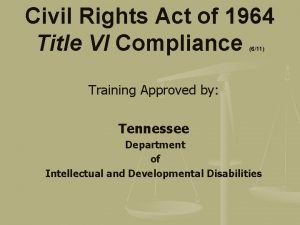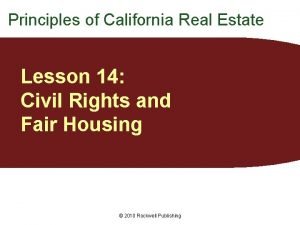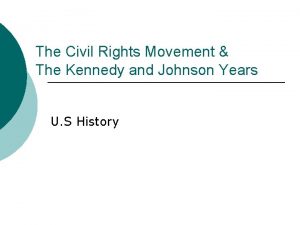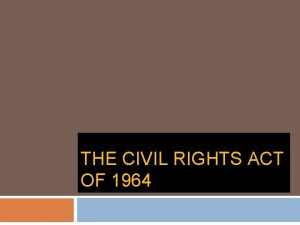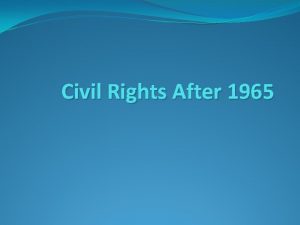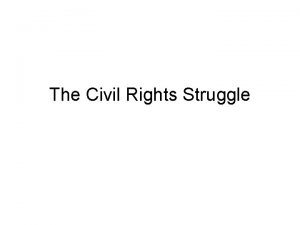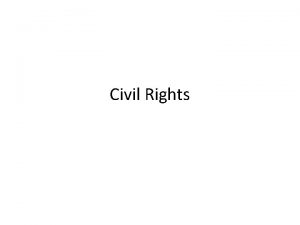The Civil Rights Act of 1964 The Struggle








- Slides: 8

The Civil Rights Act of 1964 The Struggle for Equality

Standard and Objective SSHS-S 1 C 9 -03 -c Strand 1: American History Concept 9: Postwar United States PO 3: Describe aspects of post World War II American society c. protest movements Students will

Governor Wallace George Wallace was elected as Alabama’s governor At his inauguration he said: “I draw a line in the dust… and I say, Segregation now! Segregation tomorrow! Segregation forever!” Governor Wallace stood in front of the University of Alabama to prevent two African American students from enrolling Federal Marshals were sent in to order Wallace to move

Medgar Evers Was the field secretary for the NAACP He worked for voter registration and promoted boycotts Was murdered by a white segregationist the day after Wallace’s stand He became a Civil Rights martyr and President Kennedy announced a civil rights bill

Passing Civil Rights Legislation Kennedy worked to pass the Civil Rights bill but it failed After his assassination Johnson continued the effort to pass the bill It passed the House of Representatives but got stuck in the Senate Opponents filibustered to try to prevent it from passing It still passed and the Civil Rights Act of 1964 became law Quick history of civil rights laws –the longest filibuster in history was against the passage of the Civil Rights Act of 1957 by Senator Strom Thurmond

Voting Rights Although the Civil Rights Act passed very few African Americans were able to vote Selma Alabama had a majority African American population but they made up only 3% of the registered voters Martin Luther King Jr. chose Selma as the location of their voting rights protest The Sheriff, Jim Clark deputized and armed dozens of white citizens These men used clubs and cattle prods on the protesters More than 3, 000 African Americans including children were arrested

Bloody Sunday Dr. King organized a “March of Freedom” from Selma to the state capitol in Montgomery On Sunday, March 7, 1965 the march began with 600 protesters marching Sheriff Clark ordered them to disperse when they got to the Edmund Pettus Bridge When they didn’t, many protesters were beaten in full view of television cameras 70 were hospitalized and 70 more were injured The nation and Johnson were furious, Johnson then announced that there would be a new voting rights law

The Voting Rights Act of 1965 By August, the bill passed both the House of Representatives and the Senate and became law It gave the U. S. attorney general to send federal examiners to register qualified voters This was necessary because many local officials refused to register African Americans The peaceful protests had led to anti-discrimination laws and voting rights laws
 Title vi of the civil rights act of 1964
Title vi of the civil rights act of 1964 Civil rights and civil liberties webquest
Civil rights and civil liberties webquest Chapter 14 postwar prosperity and civil rights
Chapter 14 postwar prosperity and civil rights Unruh civil rights act real estate
Unruh civil rights act real estate What did sncc accomplish and how
What did sncc accomplish and how Title vii of the civil rights act
Title vii of the civil rights act Title vii of the civil rights act
Title vii of the civil rights act Why did the struggle for equal rights intensify
Why did the struggle for equal rights intensify Urban transportation act of 1964
Urban transportation act of 1964
